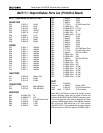
Power Base-2 & 800CSL Amplifier Service Manual
15
Checkout Procedures
Procedure Capacitive: Load each channel to 8 ohms in
parallel with 2 µF. Inject a 20 kHz sine wave with 30
VAC output for 10 seconds.
Procedure Inductive: Load each channel to 8 ohms in
parallel with 159 µHenries. Inject a 1 kHz sine wave
with 15 VAC output for 10 seconds.
Procedure Torture: Load each channel with the primary
(red and black leads) of a DC-300A transformer (D
5781-6). Inject a 10 Hz sine wave at sufficient output
level to cause 3 to 5 flyback pulses, for 10 seconds.
Procedure Short: Inject a 60 Hz sine wave at 5 VAC.
After establishing signal, short the output for 10 sec-
onds.
TEST 14: ODEP LIMITING
Spec: No oscillation on ODEP Limiting wave form;
either channel controls limiting in Parallel Mono Mode.
Initial Conditions: Controls per standard; rag or other
obstruction blocking fan so that it does not turn.
Procedure: Load the amplifier to 4 ohms on each
channel. Inject a 60 Hz sine wave and adjust for 35
Vrms at the output. After a few minutes observe a wave
form similar to Figure 4. Remove the input signal from
both channels and allow the amplifier to cool for a few
minutes. Switch the amplifier to Parallel Mono and
remove the load from Channel 1. Inject the signal into
Channel 1 and observe that ODEP limiting occurs at
the output of both channels. Remove the load from
Channel 2, and install the load on Channel 1. Again,
observe that both channels limit. Return all amplifier
controls to standard initial conditions. Remove the fan
obstruction.
TEST 15: LF PROTECTION
Spec: Amplifier mutes for low frequency.
Initial Conditions: Controls per standard.
Procedure: No load. Inject a 0.5 Hz 6 volt peak-to-peak
square wave into each channel and verify that each
channel cycles into mute.
TEST 16: SIGNAL TO NOISE RATIO
Spec: 100 dB (105 dB A-weighted) below rated 8 ohm
power.
Initial Conditions: Controls per standard. Short inputs.
Procedure: Load each channel to 8 ohms. Measure
less than 400 µV at the output of each channel (or –100
dB from reference of +36.25 dBu).
TEST 17: TURN ON TRANSIENTS
Spec: No dangerous transients.
Initial Conditions: Controls per standard.
Procedure: From an off condition, turn on the amplifier
and monitor the output noise at the time of turn on.
Note: Turn on noise may increase significantly if the
amplifier is cycled off and on.
TEST 18: TURN OFF TRANSIENTS
Spec: No dangerous transients.
Initial Conditions: Controls per standard.
Procedure: From an on condition, turn off the amplifier
and monitor the output noise at the time of turn off.
Note: Turn off noise may increase significantly if the
amplifier is cycled off and on.
TEST 19: INTERMODULATION DISTORTION
Spec at 0 dB Output: 0.01%.
Spec at –35 dB Output: 0.05%.
Initial Conditions: Controls per standard.
Procedure: Load each channel to 8 ohms. Inject a
SMPTE standard IM signal (60 Hz and 7 kHz sine wave
mixed at 4:1 ratio) at 320 Watts (41.0 VAC). With an IM
analyzer measure less than 0.01% IMD. Repeat test at
–35 dB (reference 320 Watts or 41.0 VAC) and mea-
sure less than 0.05% IMD.
TEST 20: CLIPPING
Spec: No protective action during test.
Initial Conditions: Controls per standard.
Procedure: Load each channel to 8 ohms. Inject a 1 kHz
sine wave at each input and drive output 6 dB into clip
for 10 seconds. The amplifier should not activate any
protective circuits (ODEP, Fault, or LF Protection).
Figure 4. ODEP Limiting Wave Form


















